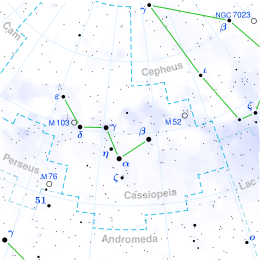
Summary
YZ Cassiopeiae (21 Cas) is a star system 103.8 parsecs (339 ly) away from Earth, in the constellation Cassiopeia. It comprises three stars: an eclipsing Algol-type binary and a visually fainter star about 3000 AU distant.[10]

The primary star in the YZ Cassiopeiae system is a white subgiant (main sequence) star of spectral type A1Vm and 2.31 solar masses[10] (M☉) with a less massive main sequence dwarf star of type F2V[2] and 1.35 M☉.[10] The apparent magnitude of the eclipsing binary varies from 5.65 to 6.05[2] with a period of 4.4672 days.[10] Combined, they appear to have a spectral type of A2IV.[10]
The binary has a dimmer (magnitude 9.7 according to Norton,[15] or 10.5 by SIMBAD) companion of 0.8 M☉[10] orbiting with a period of about 86 580 years.[10]
References edit
- ^ a b c d e van Leeuwen, F. (November 2007). "Validation of the new Hipparcos reduction". Astronomy and Astrophysics. 474 (2): 653–664. arXiv:0708.1752. Bibcode:2007A&A...474..653V. doi:10.1051/0004-6361:20078357. S2CID 18759600.
- ^ a b c Jerzy M. Kreiner, Chun-Hwey Kim, Il-Seong Nha. YZ CAS: Atlas of O-C Diagrams of Eclipsing Binary Stars
- ^ a b Hog, E.; Kuzmin, A.; Bastian, U.; Fabricius, C.; Kuimov, K.; Lindegren, L.; Makarov, V. V.; Roeser, S. (1998). "The TYCHO Reference Catalogue". Astronomy and Astrophysics. 335: L65. Bibcode:1998A&A...335L..65H.
- ^ a b c d e Eggen, O. J. (1963). "Three-color photometry of the components in 228 wide double and multiple systems". Astronomical Journal. 68: 483. Bibcode:1963AJ.....68..483E. doi:10.1086/109000.
- ^ Grenier, S.; Baylac, M.-O.; Rolland, L.; Burnage, R.; Arenou, F.; Briot, D.; Delmas, F.; Duflot, M.; Genty, V.; Gómez, A. E.; Halbwachs, J.-L.; Marouard, M.; Oblak, E.; Sellier, A. (1999). "Radial velocities. Measurements of 2800 B2-F5 stars for HIPPARCOS" (PDF). Astronomy and Astrophysics Supplement. 137 (3): 451. Bibcode:1999A&AS..137..451G. doi:10.1051/aas:1999489.
- ^ a b Bilir, S.; Ak, T.; Soydugan, E.; Soydugan, F.; Yaz, E.; Filiz Ak, N.; Eker, Z.; Demircan, O.; Helvaci, M. (2008). "New absolute magnitude calibrations for detached binaries". Astronomische Nachrichten. 329 (8): 835. arXiv:0806.1290. Bibcode:2008AN....329..835B. doi:10.1002/asna.200811002. S2CID 6131326.
- ^ Samus, N. N.; Durlevich, O. V.; et al. (2009). "VizieR Online Data Catalog: General Catalogue of Variable Stars (Samus+ 2007-2013)". VizieR On-line Data Catalog: B/GCVS. Originally Published in: 2009yCat....102025S. 1. Bibcode:2009yCat....102025S.
- ^ a b c d e f g h Pavlovski, K.; Southworth, J.; Kolbas, V.; Smalley, B. (2014). "Absolute dimensions of detached eclipsing binaries - III. The metallic-lined system YZ Cassiopeiae". Monthly Notices of the Royal Astronomical Society. 438 (1): 590–603. arXiv:1311.3482. Bibcode:2014MNRAS.438..590P. doi:10.1093/mnras/stt2229. S2CID 56144135.
- ^ Gontcharov, G. A. (2006). "Pulkovo Compilation of Radial Velocities for 35 495 Hipparcos stars in a common system". Astronomy Letters. 32 (11): 759–771. arXiv:1606.08053. Bibcode:2006AstL...32..759G. doi:10.1134/S1063773706110065. S2CID 119231169.
- ^ a b c d e f g h Tokovinin 1997-1999. J/A+AS/124/75. Multiple star catalogue (MSC)
- ^ a b c d e f g Eker, Z.; Soydugan, F.; Soydugan, E.; Bilir, S.; Yaz Gökçe, E.; Steer, I.; Tüysüz, M.; Şenyüz, T.; Demircan, O. (2015). "Main-Sequence Effective Temperatures from a Revised Mass-Luminosity Relation Based on Accurate Properties". The Astronomical Journal. 149 (4): 131. arXiv:1501.06585. Bibcode:2015AJ....149..131E. doi:10.1088/0004-6256/149/4/131. S2CID 118740259.
- ^ a b c Maxted, P. F. L.; Serenelli, A. M.; Southworth, J. (2015). "Bayesian mass and age estimates for transiting exoplanet host stars". Astronomy & Astrophysics. 575: A36. arXiv:1412.7891. Bibcode:2015A&A...575A..36M. doi:10.1051/0004-6361/201425331. S2CID 54857801.
- ^ "V* YZ Cas". SIMBAD. Centre de données astronomiques de Strasbourg. Retrieved 26 January 2018.
- ^ "MAST: Barbara A. Mikulski Archive for Space Telescopes". Space Telescope Science Institute. Retrieved 8 December 2021.
- ^ Norton, Arthur P. (1973). Norton's Star Atlas. p. 118. ISBN 0-85248-900-5.



